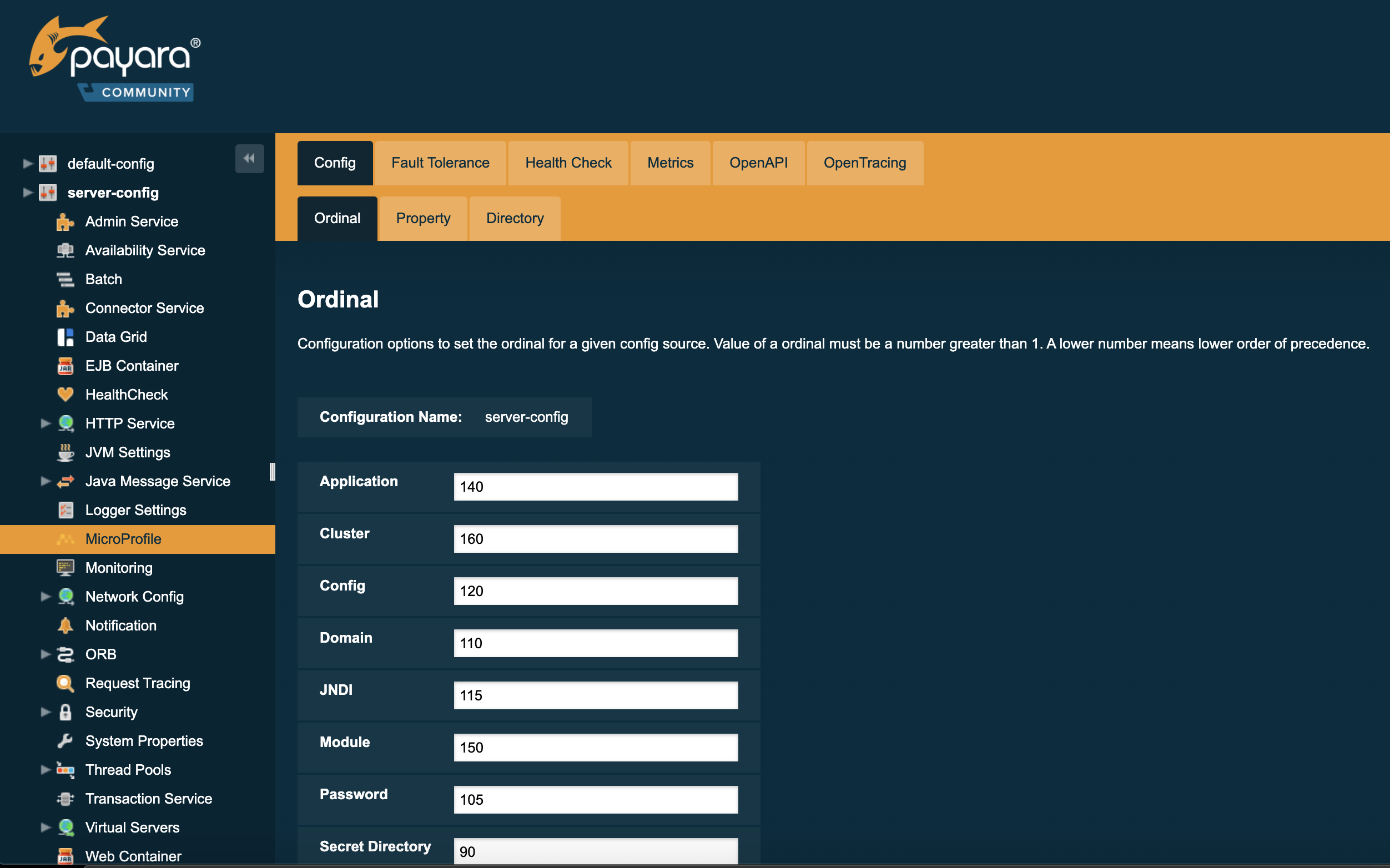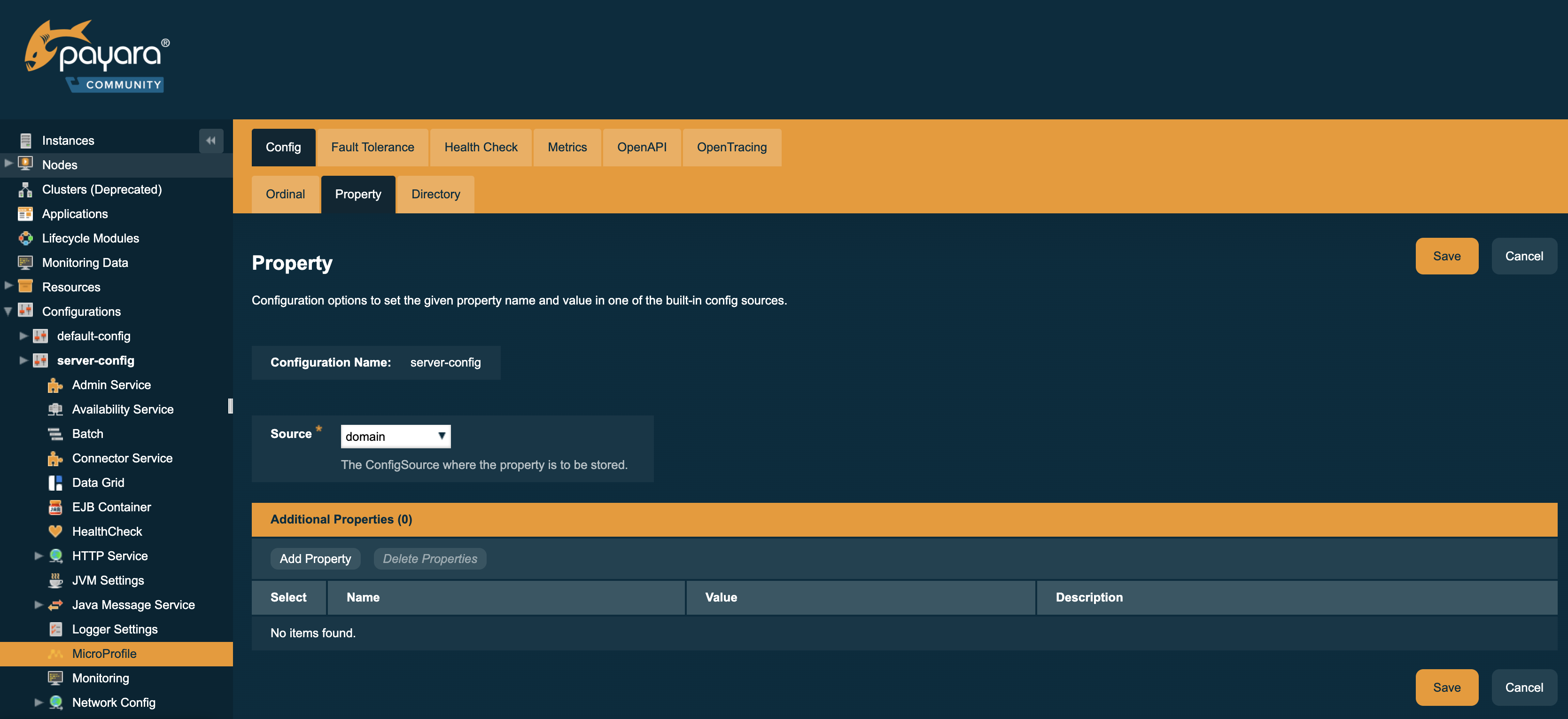Eclipse MicroProfile Config API
Provided version of the API: MicroProfile Config 3.0
Background
The Config API was created to allow for the modification of application configuration from outside the application without needing the application to be repackaged.
A full overview for the reasoning behind the API can be found in the Overview for the source code repository.
| The complete specification is maintained in the same repository. |
Config Sources
A ConfigSource is a definition of a source of configuration values that can be used by an application. In addition to the default ConfigSources outlined by the specification, the following are also supported ConfigSources:
| Where multiple configuration properties exist, the property from a source with a higher ordinal number is preferred. |
| Source | Ordinal | Description |
|---|---|---|
|
90 |
Reads configuration properties from files in a specified directory. Each file name is the configuration property name and the contents of the file are the config property value. This config source can be used to read Kubernetes secrets files. You can find out more about directory config sources here: Directory Config Sources |
|
105 |
Retrieves and stores config values in the password alias store. These will be available to all server instances in a domain. |
|
110 |
Retrieves and stores config values in the domain.xml as key values. These will then apply to all instances within a domain |
|
115 |
Retrieves and stores config values within the JNDI tree. The property name being the dotted name path in the JNDI tree and the value being stored in the JNDI tree. These are modifiable by current admin console functionality. |
|
120 |
Retrieves and stores config values at the level of the named configuration in the domain.xml; |
|
130 |
Retrieves and stores config values at the level of the server in the domain.xml. Property values will only apply on the named server instance |
|
140 |
Retrieves and stores config values at the level of the application. Property values will only be available for the specified application on all server instances it is deployed |
|
150 |
Retrieves and stores config values at the level of an individual module within an application. Property values will only be available for the specified module on all server instances it is deployed |
|
160 |
Retrieves and stores config values in the Hazelcast cluster as name value pairs. These will be available for all server instances that are members of the cluster. |
|
170 |
Reads configuration properties from a |
|
180 |
Reads configuration properties from various Cloud provider secret stores. You can find out more about our supported cloud config sources here: Cloud Config Sources |
|
190 |
Reads configuration properties from a specified database table. You can find out more about JDBC config sources here: JDBC Config Sources |
|
200 |
Reads configuration properties from a specified LDAP directory. You can find out more about LDAP config sources here: LDAP Config Sources |
Converters
In addition to the standard converters specified by the API, Payara Platform’s implementation includes out-of-the-box converters for URL and InetAddress. These have @Priority of 1, the same as the default converters.
Payara Platform Configuration Properties
In addition to the standard configuration properties, Payara Server and Micro provide a number of out-of-the-box config properties you can use in your application to find information about the runtime environment.
| Property | Description |
|---|---|
|
The type of the runtime from |
|
The name of the instance e.g. |
|
The directory which is the root of the instance installation |
|
The name of the Payara domain |
|
The directory which is the root of the Payara software installation |
|
The directory in which the server’s configuration files reside |
|
The start time of the server in |
|
The name of the configuration this server is using |
|
The administration port number of this instance |
|
The host IP address which the admin listener is listening on |
|
The HTTP port for http-listener |
|
The IP address the http listener is listening on |
|
Whether the http listener is enabled |
|
The HTTP port for https-listener |
|
The IP address the https listener is listening on |
|
Whether the https listener is enabled |
Config Ordinal Configuration
Configuration variables ordinal values can be configured by using Admin Console or via the Asadmin CLI.
Using the Admin Console
To configure the ordinal value in the Admin Console, go to Configuration → [instance-configuration (like server-config)] → MicroProfile → Config → Ordinal:

Using Asadmin Commands
A --source value of jndi is not supported for these asadmin commands yet. The JNDI ConfigSource does exist and is usable from the Config API, though.
|
set-config-ordinal
- Usage
-
asadmin> set-config-ordinal --ordinal=<integer.value> --source=domain|config|server|application|module|cluster - Aim
-
Provides a way to set the ordinal for a given config source. Where multiple configuration properties exist, the property from a source with a higher ordinal number is preferred.
Command Options
| Option | Description | Default | Mandatory |
|---|---|---|---|
|
The value of the ordinal to set. This must be a number greater than 1. A lower number ordinal means lower order of precedence. |
- |
yes |
|
The value of the source to change. Must be one of: |
- |
yes |
|
The target Payara config to apply the change to |
server (the DAS) |
no |
get-config-ordinal
- Usage
-
asadmin> get-config-ordinal --source=domain|config|server|application|module|cluster - Aim
-
Returns the ordinal value for the given ConfigSource type.
Config Property Configuration
Configuration properties can be configured by using Admin Console or Asadmin commands.
Using the Admin Console
To configure the property in the Admin Console, go to Configuration → [instance-configuration (like server-config)] → MicroProfile → Config → Property:

Using Asadmin Commands
set-config-property
- Usage
-
asadmin> set-config-property --propertyName=<property.name> --propertyValue= <property.val> --source=domain|config|server|application|module|cluster --sourceName=<source.name> --moduleName=<module.name> --target=<target[default:server]> - Aim
-
Sets the given property name and value in one of the built-in config sources. The source is specified with
--sourceand, where there is ambiguity, the--sourceNameand--moduleNameoptions can be used. For example, where the source isserver, the--sourceNamecan be used to specify the name of the server where the config property is to be stored.
Command Options
| Option | Description | Default | Mandatory |
|---|---|---|---|
|
The name of the configuration property to set |
- |
yes |
|
The value of the configuration property to set |
- |
yes |
|
The ConfigSource where the property is to be stored |
- |
yes |
|
The name of the ConfigSource when there may be ambiguity, for example a ConfigSource of type |
- |
no |
|
The name of the module when the ConfigSource is of type |
- |
no |
|
The target configuration where the command should be run |
server (the DAS) |
no |
delete-config-property
- Usage
-
asadmin> delete-config-property --propertyName=<property.name> --source=domain|config|server|application|module|cluster --sourceName=<source.name> --moduleName=<module.name> --target=<target[default:server]> - Aim
-
Deletes the given property name in one of the built-in config sources so that the property no longer exists. The source is specified with
--sourceand, where there is ambiguity, the--sourceNameand--moduleNameoptions can be used. For example, where the source isserver, the--sourceNamecan be used to specify the name of the server where the config property is to be stored.moduleNameshould only be used when the--source=module.
Command Options
| Option | Description | Default | Mandatory |
|---|---|---|---|
|
The name of the configuration property to delete |
- |
yes |
|
The ConfigSource where the property is stored |
- |
yes |
|
The name of the ConfigSource when there may be ambiguity, for example a |
- |
no |
|
The name of the module when the ConfigSource is of type |
- |
no |
|
The target configuration where the command should be run |
server (the DAS) |
no |
get-config-property
- Usage
-
asadmin> get-config-property --propertyName=<property.name> --source=domain|config|server|application|module|cluster --sourceName=<source.name> --moduleName=<module.name> --target=<target[default:server]> - Aim
-
Gets the value for the given property name in one of the built-in config sources. The source is specified with
--sourceand, where there is ambiguity, the--sourceNameand--moduleNameoptions can be used. For example, where the source isserver, the--sourceNamecan be used to specify the name of the server where the config property is to be stored.
Command Options
| Option | Description | Default | Mandatory |
|---|---|---|---|
|
The name of the configuration property to get |
- |
yes |
|
The ConfigSource where the property is stored |
- |
yes |
|
The name of the ConfigSource when there may be ambiguity, for example a |
- |
no |
|
The name of the module when the ConfigSource is of type |
- |
no |
|
The target configuration where the command should be run |
server (the DAS) |
no |
Config Cache Duration
The cache duration can be configured by using Asadmin commands. By default properties have a TTL (time to live) of 60 seconds. That means each individual property does not change for 60 seconds since it has been resolved before. Therefore it can take up to 60 seconds for changes made visible by a config source to become effective.
If properties were not resolved recently, the change can become visible faster than the cache duration or even immediately because some time already passed since they had been last resolved and cached.
Using Asadmin Commands
set-config-cache
- Usage
-
asadmin> set-config-cache --duration=<duration.in.second> --target=<target[default:server]> - Aim
-
Sets the cache duration for the target instance(s). Any duration equal to or below zero disables the caching of MP config properties.